Danske Bank Bundle
Unveiling Danske Bank: How Does It Thrive in the Nordic Financial Landscape?
Danske Bank, a financial powerhouse in the Nordic region, offers a wide array of banking services to individuals and businesses. With a strong performance, including a substantial net profit in 2023, the bank showcases its significant role in the economies of Denmark, Norway, Sweden, and Finland. Its comprehensive offerings, from loans to investments, make it a key player in the financial well-being of its customers.
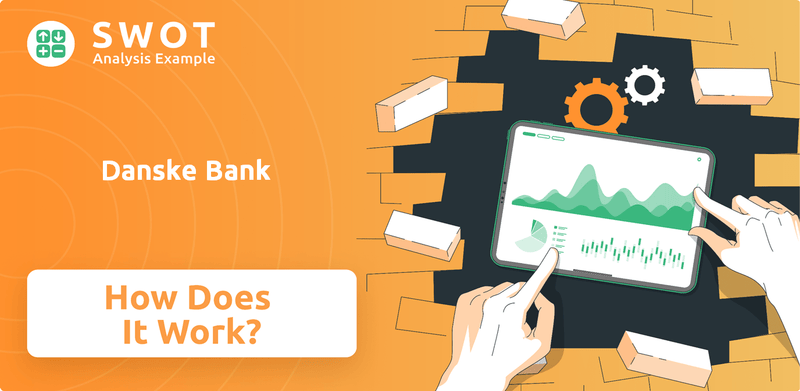
This exploration into Danske Bank SWOT Analysis will dissect the core of Danske Bank operations and its business model, examining how it generates revenue and navigates the competitive Nordic banking market. Whether you're interested in Danske Bank's financial performance, its customer service reviews, or the intricacies of its investment products, understanding the bank's strategies is crucial. We'll analyze Danske Bank’s history and background, providing insights into its sustained success and its position within the financial institution landscape.
What Are the Key Operations Driving Danske Bank’s Success?
Danske Bank, a prominent financial institution, crafts and delivers value by offering a wide array of financial products and services. These services cater to the diverse needs of its personal and business customers across the Nordic region. Its core offerings include traditional banking services, investment products, and insurance solutions.
The bank's operations are multifaceted, leveraging physical branches, digital platforms, and a robust IT infrastructure. Technology development plays a crucial role, enhancing customer experience and operational efficiency. Its customer base is supported through its branch network and digital channels.
Danske Bank's success is rooted in its strong regional focus within the Nordics and its commitment to digital transformation. This approach allows for tailored product development and customer service, supporting customers' financial goals.
Danske Bank's primary offerings include a range of banking services. These services encompass current and savings accounts, loans, and mortgages. These form the foundation of its retail banking operations.
For businesses, Danske Bank provides corporate lending, trade finance, and cash management services. It also offers capital markets services to support their growth. These services are designed to enhance operational efficiency.
The bank offers a range of investment products, including mutual funds and wealth management services. This extends its value proposition beyond conventional banking. These services help customers plan for the future.
Danske Bank also provides various insurance solutions and other financial products. These offerings aim to meet the diverse needs of its customers. This further diversifies its service portfolio.
Danske Bank's operations are supported by a combination of physical branches and digital platforms. Continuous investment in digital solutions enhances customer experience and operational efficiency. The bank's 'supply chain' involves internal financial processes and risk management frameworks.
- Digital Transformation: Danske Bank has invested heavily in digital transformation. This includes mobile banking apps and online self-service portals.
- Branch Network: The bank maintains a strong branch network to ensure accessibility for its customers.
- IT Infrastructure: A robust IT infrastructure supports its operations. This ensures the delivery of its services.
- Partnerships: Partnerships with other financial institutions are used for specialized services. This includes market access.
The Brief History of Danske Bank provides a deeper understanding of its evolution and strategic direction. In 2024, the bank reported significant financial performance, with a focus on digital banking and sustainable finance initiatives. The bank's customer service reviews reflect its commitment to customer satisfaction, and its mobile app continues to be a key feature for its users. Danske Bank's branches are located in key Nordic regions, supporting its international presence and investment products.
Danske Bank SWOT Analysis
- Complete SWOT Breakdown
- Fully Customizable
- Editable in Excel & Word
- Professional Formatting
- Investor-Ready Format
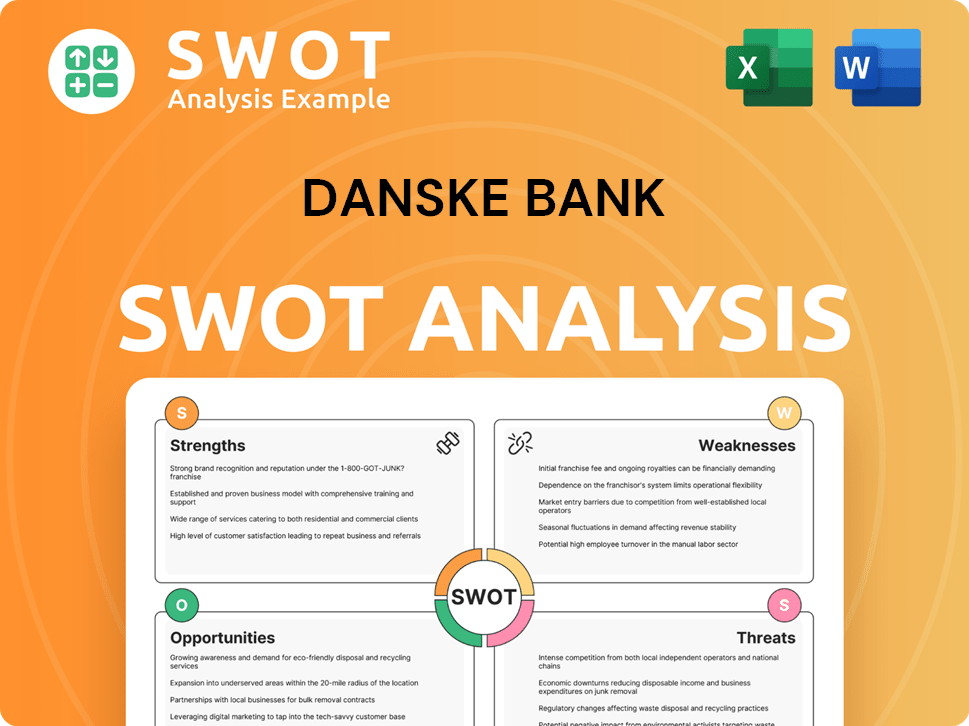
How Does Danske Bank Make Money?
Danske Bank, a prominent financial institution, generates revenue through a diverse array of income streams, reflecting its comprehensive banking services. These streams are crucial to understanding how Danske Bank operates and maintains its financial stability. The bank's business model is designed to capture value from various financial activities, ensuring a robust and resilient revenue base.
The primary revenue sources for Danske Bank include net interest income, net fee income, and net trading income. These core components are supplemented by other financial activities, contributing to the overall financial performance of the Danish bank. Analyzing these revenue streams provides insights into the bank's ability to adapt to market changes and sustain profitability.
Net interest income is a significant contributor to Danske Bank's revenue, derived from the difference between interest earned on assets like loans and interest paid on liabilities such as deposits. For the first quarter of 2024, Danske Bank reported net interest income of DKK 8.1 billion, showcasing its substantial contribution to the bank's overall revenue.
Danske Bank's revenue streams are diversified, ensuring financial stability. The bank's ability to generate income from multiple sources is a key aspect of its business model. Here are the main revenue streams:
- Net Interest Income: This is the largest revenue source, stemming from the difference between interest earned on loans and interest paid on deposits.
- Net Fee Income: Generated from various banking services like advisory fees, payment services, asset management fees, and brokerage fees.
- Net Trading Income: This income stream comes from trading activities in financial markets, including foreign exchange, equities, and fixed income.
- Other Revenue: Includes income from insurance operations and other minor financial activities.
Danske Bank employs several monetization strategies to maximize revenue. These strategies include tiered pricing for services, bundled offerings, and cross-selling opportunities. The bank also focuses on increasing assets under management in private banking and wealth management, which generates recurring fee income. For more details on the bank's operations, you can read this article about Danske Bank's financial performance.
Danske Bank PESTLE Analysis
- Covers All 6 PESTLE Categories
- No Research Needed – Save Hours of Work
- Built by Experts, Trusted by Consultants
- Instant Download, Ready to Use
- 100% Editable, Fully Customizable
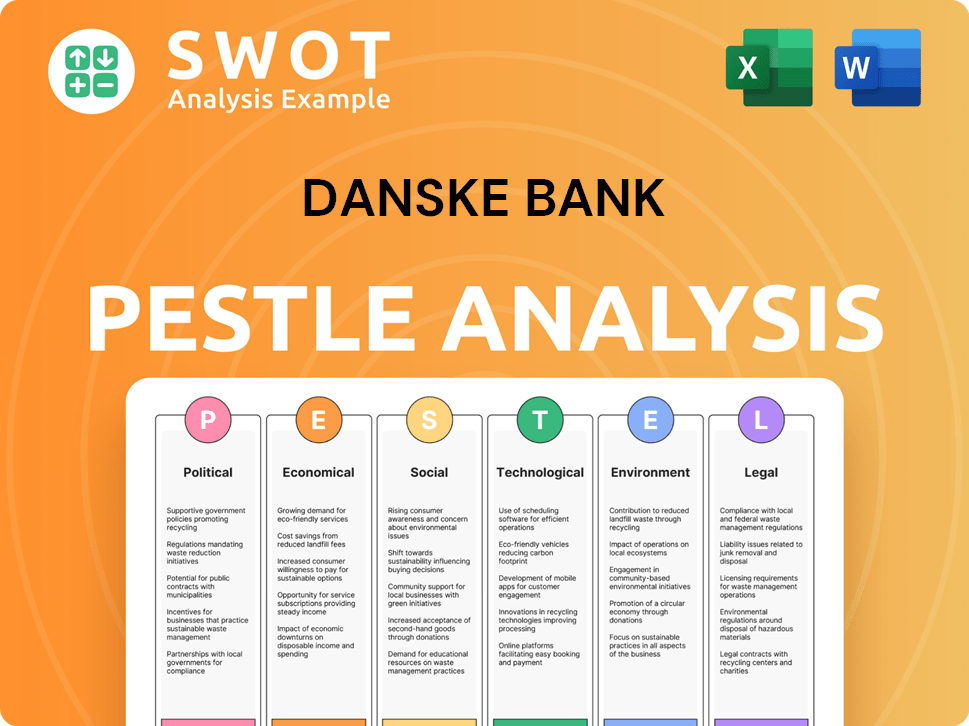
Which Strategic Decisions Have Shaped Danske Bank’s Business Model?
Danske Bank's journey has been marked by significant milestones and strategic shifts, shaping its operational and financial landscape. A key focus has been the ongoing digital transformation, with substantial investments in technology aimed at enhancing customer experiences and improving operational efficiency. This includes continuous development of mobile banking applications and online platforms to provide seamless digital services. The bank has also actively managed its portfolio, including divesting non-core assets to streamline operations and concentrate on its primary Nordic markets.
Operational and market challenges have included navigating a complex and evolving regulatory environment, particularly following past compliance issues. The bank has responded by significantly strengthening its anti-money laundering (AML) and compliance frameworks, investing heavily in systems and personnel to meet regulatory expectations. Market downturns and economic fluctuations in the Nordic region also present ongoing challenges, which the bank addresses through robust risk management and diversified lending portfolios. For example, in 2024, Danske Bank reported a net profit of DKK 14.8 billion, demonstrating its resilience amidst economic uncertainties.
The bank's competitive advantages are rooted in its strong brand recognition and long-standing presence in the Nordic countries, fostering substantial customer loyalty. Danske Bank benefits from economies of scale, enabling investments in technology and competitive pricing. Its comprehensive product offerings, catering to both retail and corporate clients, provide a one-stop-shop for financial needs, strengthening its market position. Furthermore, its ongoing commitment to digital innovation helps it adapt to new trends and competitive threats from fintech companies and other established banks. To learn more about their growth strategy, check out this article: Growth Strategy of Danske Bank.
Key milestones include the bank's digital transformation, which involves significant investments in technology to improve customer experience. This includes the development of mobile banking apps and online platforms. Danske Bank has also strategically managed its portfolio, divesting non-core assets to focus on its core markets.
Strategic moves involve adapting to the regulatory landscape, particularly in AML and compliance. The bank has invested heavily in strengthening its frameworks. Danske Bank also manages its portfolio to navigate market downturns and economic fluctuations. The bank has also been focusing on sustainable finance and green lending.
Danske Bank's competitive edge comes from strong brand recognition and a long-standing presence in the Nordic countries. It benefits from economies of scale, enabling investments in technology and competitive pricing. The bank offers a comprehensive product range for both retail and corporate clients. The bank's focus on sustainability positions it well in the market.
In 2024, Danske Bank's net profit reached DKK 14.8 billion, demonstrating its strong financial health. The bank's focus on cost efficiency and strategic investments has contributed to its profitability. The bank's capital position remains robust, with a Common Equity Tier 1 (CET1) ratio of 18.3% as of Q1 2024, well above regulatory requirements.
Danske Bank's strategic focus includes digital transformation, compliance, and sustainable finance. The bank is investing in technology to improve customer experience and operational efficiency. Strengthening AML and compliance frameworks is a priority, along with diversifying its lending portfolio.
- Digital Transformation: Investing in mobile banking and online platforms.
- Compliance: Strengthening AML and regulatory adherence.
- Sustainable Finance: Promoting green lending and sustainable initiatives.
- Customer Experience: Enhancing services to meet customer needs.
Danske Bank Business Model Canvas
- Complete 9-Block Business Model Canvas
- Effortlessly Communicate Your Business Strategy
- Investor-Ready BMC Format
- 100% Editable and Customizable
- Clear and Structured Layout
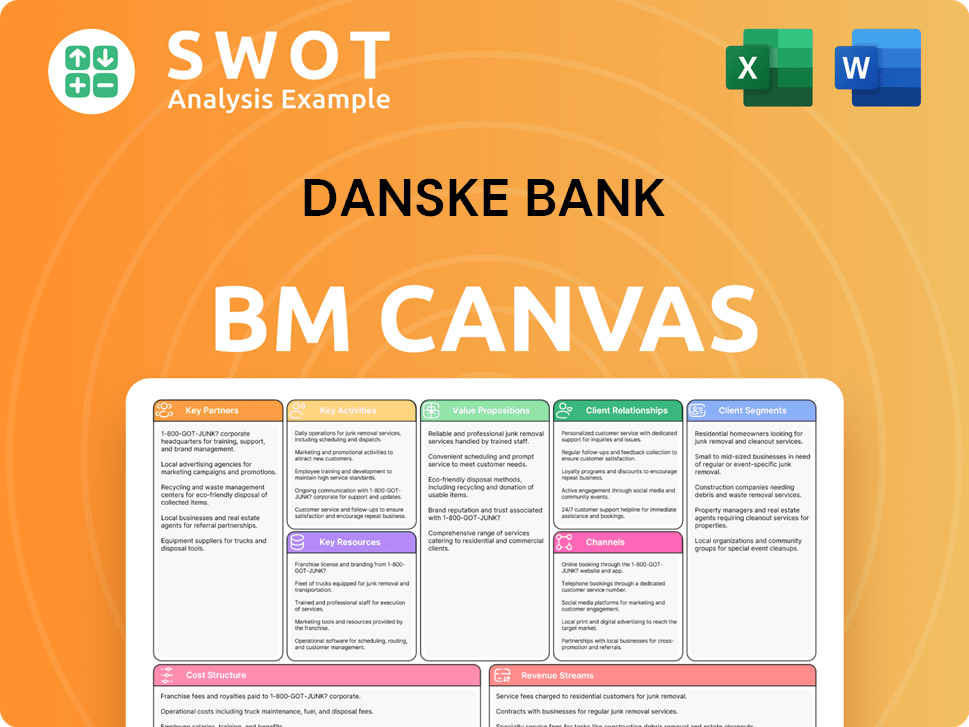
How Is Danske Bank Positioning Itself for Continued Success?
Danske Bank holds a significant position in the Nordic banking industry, competing with major players like Nordea, SEB, and Swedbank. The bank's extensive customer base and brand recognition contribute to customer loyalty, particularly in its home market of Denmark. However, the competitive landscape requires continuous innovation and service improvement to maintain its market share.
Key risks for Danske Bank include regulatory changes, the emergence of fintech competitors, and technological disruption. Changes in consumer preferences, geopolitical events, and economic downturns also pose challenges. The bank's future outlook is shaped by its strategic initiatives focused on strengthening its core business, enhancing digital capabilities, and improving operational efficiency. For further insights, explore the Growth Strategy of Danske Bank.
Danske Bank is a prominent financial institution in the Nordic region, especially in Denmark. It offers a wide range of banking services, including personal and corporate banking. The bank competes with other major Nordic banks, and its market share varies by product and region.
Danske Bank faces risks from regulatory changes, fintech competition, and technological disruption. Changes in consumer preferences and economic downturns also pose challenges. Geopolitical events can impact loan demand and credit quality. The increasing demand for sustainable financial products is also a factor.
The bank focuses on strengthening its core business, enhancing digital capabilities, and improving efficiency. Danske Bank aims to be a 'better bank' by focusing on customer satisfaction and responsible banking. It plans to grow its market share and leverage its strong Nordic position.
Danske Bank is investing in technology and optimizing its cost base. The bank is also exploring sustainable growth opportunities and partnerships. A key focus is on sustainable finance, aiming to increase its contribution to green transition financing.
Danske Bank's strategic priorities include enhancing customer experience, operational excellence, and responsible banking. The bank is committed to sustainable finance and aims to grow its market share. These initiatives are crucial for the bank's long-term success.
- Customer Satisfaction: Prioritizing customer needs and improving service quality.
- Operational Excellence: Streamlining processes and improving efficiency.
- Sustainable Finance: Increasing investments in green initiatives and sustainable projects.
- Digital Transformation: Enhancing digital capabilities and online banking services.
Danske Bank Porter's Five Forces Analysis
- Covers All 5 Competitive Forces in Detail
- Structured for Consultants, Students, and Founders
- 100% Editable in Microsoft Word & Excel
- Instant Digital Download – Use Immediately
- Compatible with Mac & PC – Fully Unlocked
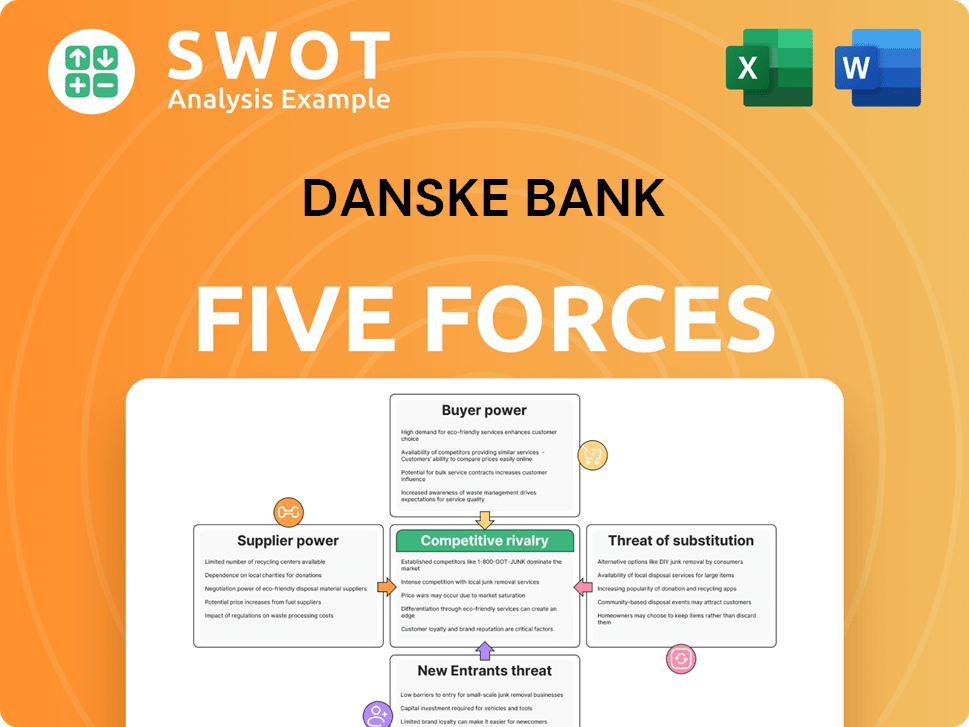
Related Blogs
- What are Mission Vision & Core Values of Danske Bank Company?
- What is Competitive Landscape of Danske Bank Company?
- What is Growth Strategy and Future Prospects of Danske Bank Company?
- What is Sales and Marketing Strategy of Danske Bank Company?
- What is Brief History of Danske Bank Company?
- Who Owns Danske Bank Company?
- What is Customer Demographics and Target Market of Danske Bank Company?
Disclaimer
All information, articles, and product details provided on this website are for general informational and educational purposes only. We do not claim any ownership over, nor do we intend to infringe upon, any trademarks, copyrights, logos, brand names, or other intellectual property mentioned or depicted on this site. Such intellectual property remains the property of its respective owners, and any references here are made solely for identification or informational purposes, without implying any affiliation, endorsement, or partnership.
We make no representations or warranties, express or implied, regarding the accuracy, completeness, or suitability of any content or products presented. Nothing on this website should be construed as legal, tax, investment, financial, medical, or other professional advice. In addition, no part of this site—including articles or product references—constitutes a solicitation, recommendation, endorsement, advertisement, or offer to buy or sell any securities, franchises, or other financial instruments, particularly in jurisdictions where such activity would be unlawful.
All content is of a general nature and may not address the specific circumstances of any individual or entity. It is not a substitute for professional advice or services. Any actions you take based on the information provided here are strictly at your own risk. You accept full responsibility for any decisions or outcomes arising from your use of this website and agree to release us from any liability in connection with your use of, or reliance upon, the content or products found herein.